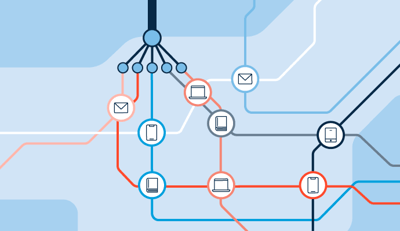June 10, 2024
 by Sagar Joshi / June 10, 2024
by Sagar Joshi / June 10, 2024

Multi-channel marketing allows you to engage with your audience where they are, all at once.
Modern customers spend ample time on digital devices and platforms. This means communicating with them through email, social media ads, blogs, search advertising, and retail stores is essential in today’s landscape.
Many marketers use cross-channel advertising software to acquire potential customers on digital channels. It helps them pitch their product and capture the audience’s attention in places where they feel most at ease.
That is why building a multi-channel marketing strategy is essential. In this guide, we will outline how to leverage it for your brand.
Multi-channel marketing uses different channels to engage and promote products or services to prospective customers.
These channels can be:
Since customers interact with your brand in many ways, the goal is to communicate with them on a platform where they’re most active. This interaction increases brand awareness and delivers a seamless brand experience. It is what 64% of your consumers expect: a consistent and smooth brand experience across different channels.
In our daily experiences, we encounter several multi-channel marketing examples. Say, while scrolling on Instagram, you click on an interesting ad for a clothing brand, leading you to the brand's website. There, you learn that they offer discounts for first-time buyers. After preliminary research, you purchase a product using the discount code through the app or store.
That's the power of a multi-channel marketing strategy. It keeps your audience hooked on different platforms and converts them into paying customers when they’re ready.
If your brand is on the right channels, it can target a wider audience, increase customer engagement, boost brand visibility, and more.
Explore how you can leverage the benefits of multi-channel marketing.
By communicating on as many platforms as possible, you cast your net wide and ensure that more customers engage with your brand. This benefit is even more apparent for brands with varied audience sets, such as an e-commerce site that caters to Gen Zs, millennials, and Gen Xs, with different content consumption patterns.
Using multi-channel marketing platforms can boost your chances of interacting with customers on their preferred channel.
Using different marketing channels, you can explore different content styles to communicate your brand's message. This flexibility is a great advantage when interacting with multiple buyer personas.
Video ads, personalized emails, blog posts, infographics, live-streaming, downloadable white papers, direct mail/brochures, etc., are all multi-channel marketing content. These formats allow you to tailor your promotions to resonate with customers on different platforms.
Multiple platforms create multiple touchpoints in the customer's journey. Brands use this to reach customers and open new communication channels for contact. It helps you build a more connected and convenient experience for customers.
Since customers often use more than three channels to review and purchase products, consistency is essential for a better customer experience. A robust multi-channel marketing strategy aids in creating this consistent brand image across platforms, leading to more brand awareness, recall, and trust.
Multi-channel marketing can attract and retain high-value customers by maximizing engagement.
The numbers tell us that companies communicating through multiple channels are more likely to increase customer loyalty and revenue.
Data analysis from these channels also equips companies to understand what platforms yield results. By focusing on the more cost-effective or high-conversion ones, you can target your marketing efforts and guarantee a better return on investment (ROI).
While the benefits are undoubtedly attractive to any marketer, it’s essential to note and tackle the challenges effectively.
To paraphrase Spider-Man, with great marketing benefits comes great responsibility.
Planning, executing, and monitoring campaigns across several mediums might seem daunting when you start your marketing efforts. In addition, you need customers to get a consistent experience across touchpoints.
Remember, you don't have to tackle everything all at once. Consider starting with a few channels where your customers are most active and then expanding to new platforms. This will help you find the right mix for your brand.
The challenge with handling different content formats and platforms is that your customers' behavior differs. Take social networking sites like LinkedIn and Instagram, for example. Longer content typically performs better on the former, while organic and short content performs better on the latter.
Maintaining a consistent brand message while providing targeted communication on different platforms is tricky with all these differences.
To get the most out of your strategy, you must spend enough time and money finding the right mix of channels.
However, it doesn’t stop there. A deep understanding of how different channels work, creating targeted content, tracking communications across channels, and analyzing the data is needed. These tasks require a team of professionals or marketing automation tools, online reputation management (ORM) tools, and more.
While it can be an intensive and expensive affair, the data demonstrates that this investment is worth it in the long run.
Can you use these phrases interchangeably? No, because although each strategy involves different channels, the approach is distinct.
For every marketing strategy, multi-channel is the first step to consider. This approach uses multiple channels to reach the customer, but not in a connected manner. Rather, communication between the brand and the customer happens independently on different channels.
Here, messaging and strategies differ across channels because each channel serves a specific objective for the brand. For example, a billboard advertisement targets a broader audience, most of whom might be unaware of the brand. However, email marketing can target past customers, incentivizing them with coupons to make repeat purchases.
Such multi-channel marketing campaign examples are more brand-centric, as they prioritize the brand's marketing goals. It lays the foundation for omnichannel and cross-channel strategies.
The customer journey crosses multiple channels, but the message and objectives are uniform. Communication seamlessly flows between these touchpoints, ensuring customers can effortlessly transition between channels, even if they leave midway.
Imagine a buyer, Sam. They find your website through pay-per-click (PPC) ads and notice an offer when visitors sign up with their email. After submitting their details, Sam gets an instant discount code with a “welcome” message. Then, they use the code to purchase and receive a confirmation via email with a survey to rate their experience.
In this example, communication with the brand happens across different platforms, but they’re all connected to improve the customer experience.
Omnichannel marketing goes one step beyond cross-channel to create a more interconnected customer journey across online and offline platforms.
Continuing the above example, Sam returns to the site to find personalized recommendations based on past purchases. The site also suggests stores where they can “try and buy” depending on location. Sam lists three products to try. On reaching the store, they share their contact number, and the salesperson confirms that these products have been set aside for trial.
The marketing strategy here aims to tailor a satisfying experience for Sam and other customers. It breaks down silos of online and offline channels of communication for the customer and gives marketers a holistic profile.
Follow the steps below to create a multi-channel marketing strategy for your business.
Before creating a marketing strategy, you must build your ideal buyer personas. It will help you define the parameters of the right audience, including demographics, likes, dislikes, motivations, channel preferences, and more.
You can collect this data through various research tools, such as customer surveys, social listening, consulting with sales or customer service teams, etc.
Managing multiple channels can be a challenge. You must choose the right management app to cut your effort in half. An excellent multichannel marketing platform should help:
Successful multi-channel marketing is not just about the right audience and platforms but also the right message.
Begin by establishing the tone you wish to convey to your audience, and then create a brand image and tonality around that vision. By crafting messages according to the channel's format or audience behavior, you can portray a unified image across channels.
Maintaining this consistency also contributes to your customer's experience and improves brand recall.
Once you have built your strategy, the next step is measuring cross-channel performance. This allows you to track the results of each touchpoint accurately and highlight areas for improvement or optimization.
To determine your marketing results, set goals according to the specific, measurable, achievable, relevant, and time-bound (SMART) framework and measure campaign performance against them.
Determine the ROI of each channel to understand if your investment is paying off. For example, when running a PPC campaign, set a certain return percentage based on projections and track your campaign to see if it meets this goal.
The most crucial marketing metric is attribution. It outlines the channels that successfully engage or convert customers and helps fine-tune your strategy to improve ROI.
Dayna Rothman, Former VP of Marketing and Sales Development at Bright Funnel, says, “Leveraging data to understand what marketing touches work enables you to orchestrate your customer journey better and show marketing's impact on revenue.”
In her webinar, she highlights these key points to track when focusing on attribution:
Explore the best marketing attribution tools to gain deeper insights, optimize your campaigns, and maximize ROI with data-driven decision-making.
Remember to track other KPIs, such as conversion rate from a channel, cart abandonment rate for retargeting campaigns, and customer retention rate.
Examine all the uncovered data and experiment with A/B testing messages to see what to keep and discard, optimize your mix of channels, and derive the best sale path.
Multi-channel marketing is not optional-it’s the key for brands to garner attention. Arm yourself with the correct data and insights, and then choose a few channels to kickstart your efforts. Although it might take some time, it's important to recognize that trial and error is an effective way to find the channels for your multi-channel marketing strategy.
Continuously track and optimize your efforts, and in a few fruitful months, you will be on your way to increasing your customer base and revenue.
Learn more about contextual advertising and reach the right people in a personalized way.
Sagar Joshi is a former content marketing specialist at G2 in India. He is an engineer with a keen interest in data analytics and cybersecurity. He writes about topics related to them. You can find him reading books, learning a new language, or playing pool in his free time.
Consistency is the key to everything.
.jpg) by Aayushi Sanghavi
by Aayushi Sanghavi
With the average buying journey growing more complex, businesses turn to multi-touch...
 by Jeremy Sacramento
by Jeremy Sacramento
Traditionally, sales couldn’t be scaled unless you hired more salespeople or marketers, and...
 by Mehdi Hussen
by Mehdi Hussen
Consistency is the key to everything.
.jpg) by Aayushi Sanghavi
by Aayushi Sanghavi
With the average buying journey growing more complex, businesses turn to multi-touch...
 by Jeremy Sacramento
by Jeremy Sacramento


